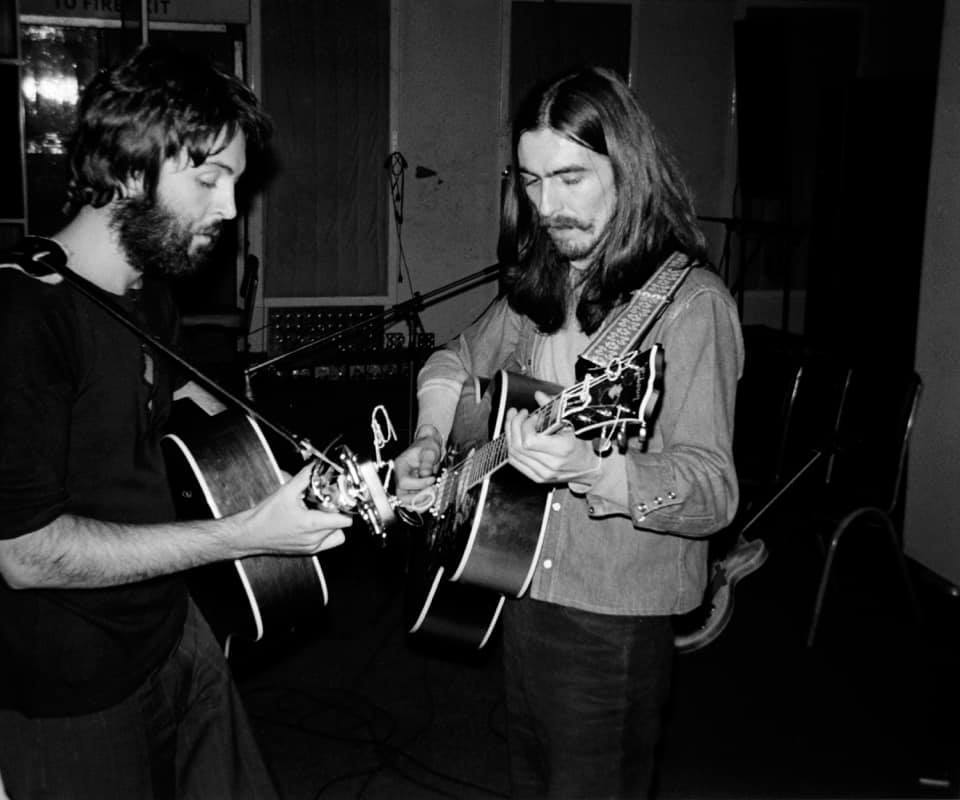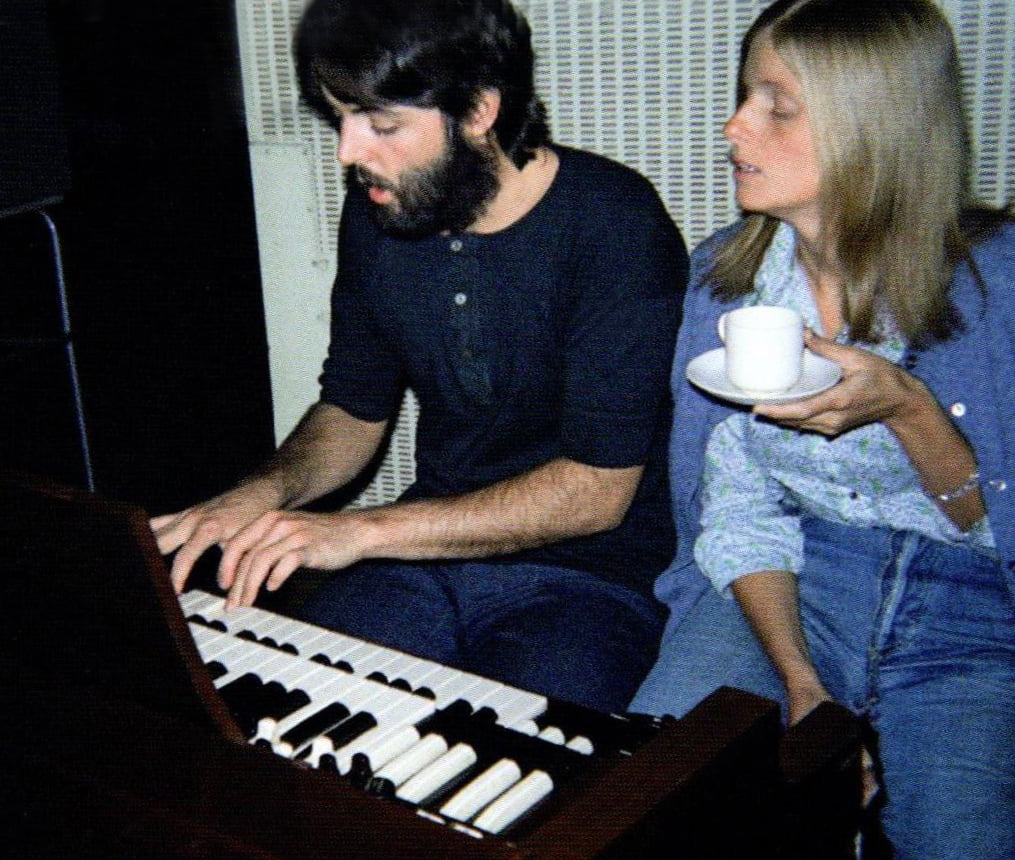Saturday, January 3, 1970
Recording "I Me Mine" for the "Get Back" album (4th compilation)
For The Beatles
Last updated on January 12, 2022
Saturday, January 3, 1970
For The Beatles
Last updated on January 12, 2022
Recording studio: EMI Studios, Studio Two, Abbey Road
Previous session Dec 21, 1969 • Mixing the "Get Back" album (4th compilation)
Article Dec 31, 1969 • New years eve party at Ringo's
Album Jan 01, 1970 • "Kum Back" by The Beatles released in the US
Session Jan 03, 1970 • Recording "I Me Mine" for the "Get Back" album (4th compilation)
Session Jan 04, 1970 • Recording and mixing "Let It Be"
Session Jan 05, 1970 • Mixing "I Me Mine", "Across The Universe" for the "Get Back" album (4th compilation)
Some of the songs worked on during this session were first released on the "Let It Be (Limited Edition)" LP.
The last time the four Beatles were together in a recording studio was on August 20, 1969. A month later, on September 20, John Lennon announced to the other Beatles that he was leaving the band.
But, on this day (and the day after), Paul McCartney, George Harrison and Ringo Starr were back at Abbey Road to work on the still unreleased “Get Back” album and record George’s song “I Me Mine“. John Lennon was on holiday in Denmark at the time.
On January 8, 1969, during the “Get Back” sessions at Twickenham, George was filmed playing “I Me Mine” on acoustic guitar to Ringo. After that, the song had not been worked on at all during the later sessions at Apple Studios. As director Michael Lindsay-Hogg had decided to include George playing “I Me Mine” in the upcoming documentary about those sessions, it was decided that the song had to appear on the accompanying album and needed to be properly recorded.
During this session which lasted from 2:30 pm to 12:15 am, the three Beatles recorded sixteen takes of the basic track of “I Me Mine“, with George on acoustic guitar (track 4) and guide vocal (track 7), Paul on bass (track 3) and Ringo on drums (tracks 1 and 2).
Between take 6 and 7, they relaxed and performed an instrumental jam.
Before take 11, they went through a brief cover of The Everly Brothers’ “Wake Up Little Susie” (released on the “Let It Be” 50th anniversary boxset in 2021, along with take 11). And before take 12, George led the two others through a version of Buddy Holly’s “Peggy Sue Got Married“.
Before take 15, George invented and declaimed a mock press statement in reference to John’s absence:
George: You all will have read that Dave Dee is no longer with us. But Mickey and Tich and I would just like to carry on the good work that’s always gone down in number two.
Paul: What Dozy says goes for me and Tich!
This remark made reference to the English beat band Dave Dee, Dozy, Beaky, Mick & Tich, and the recent press announcement (in September 1969) that Dave Dee was leaving the band.
The last take, Take 16, was considered to be the best, and they added overdubs onto it. From beatlesebooks.com:
First off, Ringo’s drums from tracks 1 and 2 were combined onto track 8, Paul recording an electric piano part onto track 1 and George recording an electric guitar part onto track 2. Onto track 5, George and Paul performed acoustic guitar licks simultaneously with George adding yet another lead guitar part in places where the acoustic guitars were not heard. Onto track 6, Paul performed an impressive Hammond organ part, while George’s lead vocals were recorded onto track 7 along with Paul’s harmony during the “I-I-I-me-me-mine” section (documented as the “bop piece”). One final overdub was performed on this day, this being George double-tracking his final lyric “All through your life, I me mine” onto track 2 where no lead guitar work was present. Interestingly, photographic evidence from this day shows George playing John’s Epiphone Casino guitar in his absence, this quite possibly being the electric guitar used on this recording.
This take 16 including overdubs was released on “Anthology 3” in 1996 and also included the mock press statement invented by George:
Pre-take 15 and take 16. A quick run-through of George Harrison’s I Me Mine (shot in early January 1969 during the Twickenham rehearsal period of the Get Back project) was set for inclusion in the Let It Be film, indicating that it also should feature on the accompanying album. But as the song had never been committed to tape with any serious endeavour the Beatles convened again in number two studio at EMI – some five months after completing final album Abbey Road – and recorded their last new piece together. (The word “new” is an important qualifier, for work polishing up previously recorded material for Let It Be continued through to April.) But not all of the Beatles participated: John Lennon was on holiday, his absence prompting a telling remark – like a mock press statement – from George during the session, which precedes this Anthology recording.
From the liner notes of “Anthology 3”
Proper mixing would be done by Glyn Johns on January 5. At this stage, “I Me Mine” lasted 1’34”. It would be 51-seconds longer when released on the “Let It Be” album, after having been re-edited and re-produced by Phil Spector.


Written by George Harrison
Recording • Take 1
Written by George Harrison
Recording • Take 2
Written by George Harrison
Recording • Take 3
Written by George Harrison
Recording • Take 4
Written by George Harrison
Recording • Take 5
Written by George Harrison
Recording • Take 6
Instrumental jam
Recording
Written by George Harrison
Recording • Take 7
Written by George Harrison
Recording • Take 8
Written by George Harrison
Recording • Take 9
Written by George Harrison
Recording • Take 10
Written by Felice Bryant, Diadorius Boudleaux Bryant
Recording
AlbumOfficially released on Let It Be (50th anniversary boxset)
Written by George Harrison
Recording • Take 11
AlbumOfficially released on Let It Be (50th anniversary boxset)
Written by Buddy Holly
Recording
Written by George Harrison
Recording • Take 12
Written by George Harrison
Recording • Take 13
Written by George Harrison
Recording • Take 14
Written by George Harrison
Recording • Take 15
Written by George Harrison
Recording • Take 16
AlbumOfficially released on Anthology 3
The Complete Beatles Recording Sessions • Mark Lewisohn
The definitive guide for every Beatles recording sessions from 1962 to 1970.
We owe a lot to Mark Lewisohn for the creation of those session pages, but you really have to buy this book to get all the details - the number of takes for each song, who contributed what, a description of the context and how each session went, various photographies... And an introductory interview with Paul McCartney!
Paul McCartney: Music Is Ideas. The Stories Behind the Songs (Vol. 1) 1970-1989
With 25 albums of pop music, 5 of classical – a total of around 500 songs – released over the course of more than half a century, Paul McCartney's career, on his own and with Wings, boasts an incredible catalogue that's always striving to free itself from the shadow of The Beatles. The stories behind the songs, demos and studio recordings, unreleased tracks, recording dates, musicians, live performances and tours, covers, events: Music Is Ideas Volume 1 traces McCartney's post-Beatles output from 1970 to 1989 in the form of 346 song sheets, filled with details of the recordings and stories behind the sessions. Accompanied by photos, and drawing on interviews and contemporary reviews, this reference book draws the portrait of a musical craftsman who has elevated popular song to an art-form.
Eight Arms to Hold You: The Solo Beatles Compendium
We owe a lot to Chip Madinger and Mark Easter for the creation of those session pages, but you really have to buy this book to get all the details!
Eight Arms To Hold You: The Solo Beatles Compendium is the ultimate look at the careers of John Lennon, Paul McCartney, George Harrison and Ringo Starr beyond the Beatles. Every aspect of their professional careers as solo artists is explored, from recording sessions, record releases and tours, to television, film and music videos, including everything in between. From their early film soundtrack work to the officially released retrospectives, all solo efforts by the four men are exhaustively examined.
As the paperback version is out of print, you can buy a PDF version on the authors' website
If we modestly consider the Paul McCartney Project to be the premier online resource for all things Paul McCartney, it is undeniable that The Beatles Bible stands as the definitive online site dedicated to the Beatles. While there is some overlap in content between the two sites, they differ significantly in their approach.

Notice any inaccuracies on this page? Have additional insights or ideas for new content? Or just want to share your thoughts? We value your feedback! Please use the form below to get in touch with us.
Chris • 2 months ago
January 3, 1970 Jam Session (1 & 2)
Apparently A Warm Up Before Continuing Another Take Of "I Me Mine".
And In This Jam You'll Hear A Hint Of McCartney's Maybe I'm Amazed
Enjoy!!!
Rui